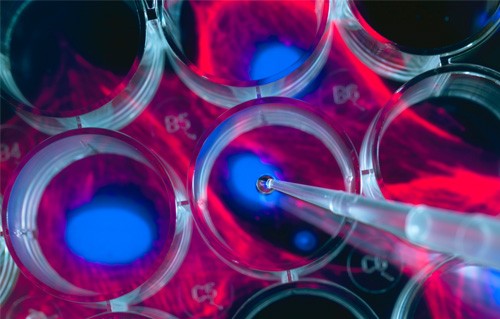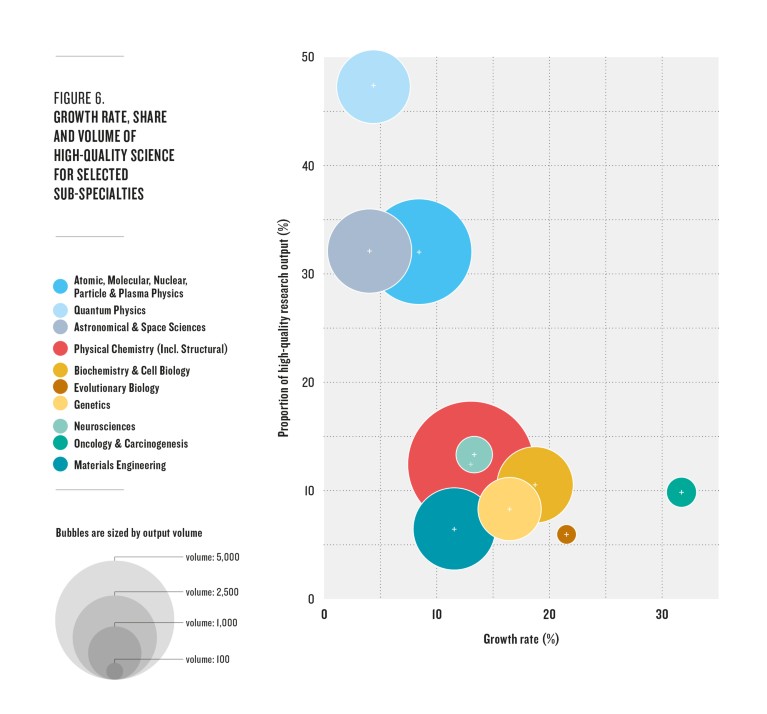
In high-quality output, medical and health research is growing strongly despite not being a traditional strength for CAS. Credit: Andrew Brookes·Getty
A closer look at high-quality research output by sub specialities provides deeper insights into CAS’s strengths. Here, basic science subjects, particularly in chemical and physical sciences, are still dominant, while applied subjects, in engineering and medical and health sciences, again exhibit the greatest growth.
Top sub specialities by overall output
Across all the sub specialities, CAS publishes most high-quality papers in physical chemistry (5,557 since 2008). Indeed, this is also the sub speciality with the largest volume of total output. Physical chemistry is the basis of many material engineering technologies, so has many applications in both basic research and society more broadly. The next strongest fields are in the physical sciences: atomic, molecular, nuclear, particle, and plasma physics (3,871 papers), and astronomical and space sciences (2,454 papers).
These basic science fields have also received increased numbers of external grants over the past decade. The physical subjects in particular require big science facilities, such as powerful particle accelerators and large radio telescopes. As part of the Pioneer Initiative, CAS has built Mega-Science Research Centers, which provide facilities and platforms for innovative basic research of strategic importance. The Daya Bay Neutrino Experiment, led by the CAS Institute of High Energy Physics, is an example of CAS’s research capacity in this field. It involved several international partners and succeeded in measuring the third type of neutrino oscillation in 20121.
Materials engineering and biochemistry and cell biology also have more than 2,000 high-quality publications apiece. The latter accounted for more than half of all high-quality papers in the biological sciences and had a CAGR of nearly 19%, the second fastest in the field. Several biochemistry papers have come from the two recently opened centres of excellence, led by the Shanghai Institute of Biological Sciences (SIBS) and the Institute of Biophysics (IBP) in Beijing. IBP also led a ‘Priority’ programme studying biomacromolecules, which ran from 2014 to 2018. SIBS is leading another, ongoing ‘Priority’ programme that explores the molecular regulation of cell fate.
Concentration of high quality research
Another way to identify CAS’s strongest research fields is to examine the percentage of high-quality research, namely, the proportion of the output of each sub speciality published in Nature Index journals. Here, several physical and chemical science subjects stand out, suggesting CAS’s robust research capacity (Figure 6).

Quantum physics, in particular, has the highest concentration of high-quality research. Roughly one in every two quantum physics papers is published in a Nature Index journal, a proportion that has remained fairly stable over the past 10 years. Two other physical science subjects, astronomical and space sciences, as well as atomic and molecular physics, have around 33% of papers in the high-quality group. In addition, inorganic chemistry and organic chemistry, two traditional strengths of CAS, have around 17% papers in Nature Index journals.
Quantum physics: A quantum revolution linking basic science and application
Quantum physics examines the fundamental energy and sub-atomic particles of the universe and it represents a growing opportunity for CAS. Thanks to generous governmental support, a number of large, strategically important frontier research facilities have been constructed in recent decades. CAS has turned this advantage into large numbers of high-quality publications and, crucially, into real-world applications.
The Quantum Experiments at Space Scale (QUESS)2, which CAS initiated in 2011 as a ‘Priority’ programme is one such project. QUESS is led by Jianwei Pan from the University of Science and Technology of China (USTC), which was established by CAS in 1958, and it made headlines in 2016 when it launched the world’s first quantum satellite.
Named Micius (or Mozi in Chinese), after the ancient Chinese philosopher, the satellite marked a giant step for quantum communication. Pan’s team sent entangled photons from Micius to two ground stations more than 1,200 kilometres apart, demonstrating their potential as quantum keys to achieve ultra-secure communications3. This built on an earlier result where Pan’s team demonstrated quantum teleportation and entanglement distribution over about 100 km in ground-based experiments. The CAS team has gone on to construct a 2,000 km ground link between Beijing and Shanghai to send quantum-encrypted keys. The link will enable eavesdrop-proof data transmission, making it the world’s longest terrestrial quantum key distribution network.
Another project, also initiated by Pan, is a 2012 ‘Priority’ programme designed to study coherent control of quantum systems. In that programme, Pan seeks to apply basic theories in quantum physics to quantum computation. By manipulating multi-photon entanglement, Pan’s team developed the first quantum computing prototype, which outperformed early-generation classical computers in modelling photon behaviours4. “Our architecture is feasible to be scaled up to a larger number of photons and with a higher rate, to race against increasingly advanced classical computers,” the authors wrote in a Nature Photonics paper5.
Collaboration among CAS research groups, and between CAS and other universities, helps propel CAS’s quantum research. One such example is the Center for Excellence in Quantum Information and Quantum Physics, established in 2014 as one of the first five CAS centres for excellence. Led by USTC, the centre includes interdisciplinary resources from the Shanghai Institute of Technological Physics and the Institute of Semiconductors at CAS. It also led the development of the quantum computing prototype alongside the CAS Institute of Physics, Zhejiang University and industry. Meanwhile, Pan’s team is working with industry and local governments to commercialize research in quantum communication and quantum information.
To maintain its edge in quantum physics, CAS also embraced student education. As Pan said in an interview with MIT Technology Review6, “we are working hard to develop the workforce of the future in quantum technology.” And the capacity to integrate research and education also underlies CAS’s success in research output.
Health is a growing concern
When looking at growth, applied science subjects have the greatest potential. The highest-growth subject across all sub specialities, with a nearly 32% CAGR, is oncology and carcinogenesis. It is followed by electrical and electronic engineering, with a CAGR of almost 28%. Immunology and clinical sciences also have CAGRs above 20%. Though the total output over the past decade is not large, their fast rise suggests an increasing focus on health-related research, which is reflected in the broader Chinese scientific community.
Cancer research: A healthy growth
Medical and health sciences are not a traditional strength for CAS. Out of CAS’s 100-plus institutes, fewer than 10 have an explicit medical science focus, a majority of which have been established since the turn of the century. However, this type of research is rapidly growing at CAS, and no subject is growing faster than oncology and carcinogenesis: the study of cancer, including its formation and treatment.
Breakthroughs in genomics, immunology and stem cell research have spurred the development of cancer therapies. At CAS, the central government’s ‘Healthy China’ initiative, which emphasizes disease prevention, chronic disease management and high-quality treatment, drove efforts to translate basic research in fields like biological sciences, chemistry, and physics into medical and health innovations.
The focus on clinical application is explicit in a CAS ‘Priority’ programme initiated in 2016, which aimed at developing personalised drugs based on improved understanding of molecular mechanisms of diseases and genetic differences between patients. With developing cancer drugs as a major component, objectives were clearly set to identify biomarkers for drug targets, and obtain new drug certificates.
Led by the Shanghai Institute of Materia Medica (SIMM), in collaboration with other institutes at SIBS, and IBP in Beijing, this programme links basic research to clinical medicine. “In this billion dollar programme, we are trying to apply the concept of molecular typing for diseases to drug discovery,” said Jia Li, the director of SIMM, at the 2019 Pujiang Innovation Forum7.
One representative result is a 2018 Cell paper, led by Meiyu Geng of SIMM, reporting potential of a precision treatment strategy for a specific kind of solid tumours by targeting epigenetic crosstalk8. The result may inform drug development for this tumour.
Apart from biological or health sciences-related institutes, other CAS institutes also contribute to oncology research. The National Center for Nanoscience and Technology (NCNST), for instance, is developing nanorobots to deliver cancer drugs. In this intelligent system, programmed DNA is folded when entering the bloodstream and unfolds at the tumour site to dispense a cancer-fighting protein9. “This breakthrough integrates nanotechnology with molecular biology,” said Yuliang Zhao, director of NCNST who led this Nature Biotechnology study. “It will open a new realm for nanomedicine.”
Much of CAS’s oncology work is cross-disciplinary between physical science and biomedical researchers. NCNST researchers also use nanoparticles to improve cancer imaging, and to combine therapeutic and diagnostic action. Moreover, researchers at the CAS Institute of Physics work with hospital partners to develop improved probing techniques for cancer detection.
Further development of cancer research requires closer integration between CAS’s many institutes and more cross-disciplinary collaboration between physical science and biomedical researchers, and even clinicians. Just as some nanoscience experts outline, the research should be guided by clinical need, as after all, the ultimate goal is to benefit cancer patients.
To promote such clinical application, CAS signed an agreement in early 2019 with the Zhejiang provincial government to establish the Institute of Cancer and Basic Medicine based on Zhejiang Cancer Hospital (which will itself be named the Cancer Hospital of the University of Chinese Academy of Sciences). As CAS’s first dedicated cancer research institution, it will link basic, clinical and translational research, seeking to commercialize its results. Future growth in cancer research output is expected to follow, along with greater clinical benefits.



 Chinese Academy of Sciences
Chinese Academy of Sciences